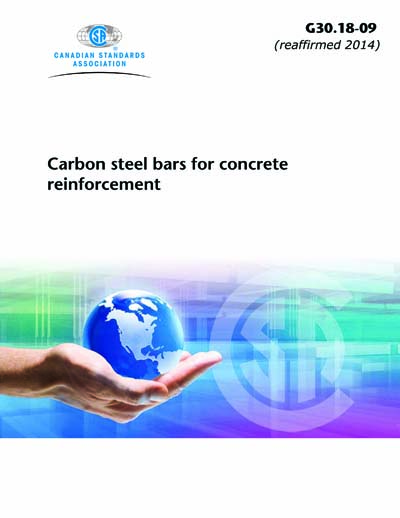Historical
CSA G30.18-09 (R2019)
Carbon steel bars for concrete reinforcement
Preface This is the second edition of CSA G30.18, Carbon steel bars for concrete reinforcement. It supersedes the previous edition, published in 1992 under the title Billet-Steel Bars for Concrete Reinforcement. The 1992 edition combined the requirements of CSA Standards G30.12-M, Billet-Steel Bars for Concrete Reinforcement, and G30.16-M, Weldable Low Alloy Steel Deformed Bars for Concrete Reinforcement, and superseded the 1977 editions of these two Standards. Scope 1.1 This Standard specifies requirements for two types of hot-rolled deformed carbon steel bars, designated regular (R) and weldable (W). The designation R is used for specifying, ordering, and communication only and is not rolled onto the bar. The designation W is rolled onto the bar (see Clauses 5 and 15). The two types are distinguished by their chemical composition requirements (see Clause 7). The bars can be in cut lengths or coils. Plain bars (Type R only) are also included in this Standard. 1.2 R grades are intended for general applications. W grades are appropriate for applications where any of the following conditions are desirable: (a) enhanced weldability; (b) enhanced ductility; (c) restricted mechanical properties; or (d) restricted chemical composition. 1.3 This Standard specifies two minimum yield strength levels, i.e., 400 MPa (designated as Grades 400R and 400W) and 500 MPa (designated as Grades 500R and 500W) (see Table 4). 1.4 Bars produced to this Standard can be welded under appropriate conditions if caution is used. Note - See CSA W186 for requirements for welding of reinforcing bars. 1.5 In CSA Standards, "shall" is used to express a requirement, i.e., a provision that the user is obliged to satisfy in order to comply with the standard; "should" is used to express a recommendation or that which is advised but not required; "may" is used to express an option or that which is permissible within the limits of the standard; and "can" is used to express possibility or capability. Notes accompanying clauses do not include requirements or alternative requirements; the purpose of a note accompanying a clause is to separate from the text explanatory or informative material. Notes to tables and figures are considered part of the table or figure and may be written as requirements. Annexes are designated normative (mandatory) or informative (non-mandatory) to define their application.
Content Provider
CSA America, Inc. [csa]






